|
While all of this applies to women too, it's harder to get
men to think about the practical usefulness and comfort of skirts, so this
is directed at the men.
"Self-respect is the noblest
garment with which a man may clothe himself, the most elevating feeling
with which the mind can be inspired." - Samuel Smiles
I know that for some men in our culture, the idea of
wearing something commonly seen as women's clothing is a Very Big Deal, so let's get over that hump
first. We aren't talking about wearing women's clothing here.
We aren't talking about cross dressing. Hey, if that floats your
boat, then go for it, but I look lousy in a sundress. What I am
doing is inviting you to consider wearing a traditional MALE garment.
Alexander the Great conquered the known world in a skirt. Think
about it.
In modern Western Civilization, the appearance of a man in a
skirt - unless that skirt is part of some kind of costume - engenders a
range of response from total disregard to curious inquiry to obstinate
denouncement. Masculinity is a fluid term, applied to men across
class and racial backgrounds. It is a product of society's need for
classification to keep people in constant relation to each other.
Masculinity serves a useful purpose, but it creates problems by creating
standards of thought, personality, and fashion for all men, regardless of
other forms of individuality. This is the problem of clothing, and
there are many books on the subject. Because we wear clothes and no
longer have access to sexual and gender clues, our clothing takes the
place of these cues and being able to classify people as the appropriate
gender according to their clothing has become second nature in our
society. Anyone who violates the common perception of these gender
cues will generate a little attention - no matter how flawed or uninformed
the common perception actually is. The common result is that even
many men are confused about how to play out their own gender
roles.
Even some men who wear skirts are very insistent that they
aren't wearing a skirt, despite the obvious fact that they are. I
mean, if you're walking around with a turtle on your head and someone asks
you why you have a turtle on your head, then to say, "It isn't a
turtle, it's a tortoise.", isn't useful. You haven't made any
real distinction or answered the question of the inquirer. But, if
it makes you feel better, then go right ahead and play the semantics
game. Don't call it a skirt. Call it a loincloth
if you have to. If you don't like loincloth, there are many other
words to choose from. Here is a list:
-
dirndl
-
loincloth
-
kilt
-
midi
-
muumuu
-
pannier
-
sarong
-
pareo
-
pareau
-
pakome (Thailand)
-
lava-lava (Samoa)
-
sulu (Fiji)
-
canga (Brazil)
-
tupenu (Tonga)
-
ki-koi (Kenya)
-
lunghi
-
robe
-
kimono
-
toga
-
tunic
-
alb
-
dhoti
There are probably more, but
I don't know them all. If somebody knows another one, post it to me
using the form at the bottom of this page and I'll add it to the list.
Just know that when you're having the, "It's NOT a skirt, stupid,
it's a KILT.", that you aren't fooling anybody. A Kilt *is* a
skirt by definition. You'll do better to stop arguing and start
educating. In the consciousness of society there are things that are
decidedly male garments and things that are decidedly female
garments. Men don't wear bras or string bikini bathing suit
tops. Women don't wear... Ah... What don't women wear? Ties? I
think I've seen women in ties... Hmmm... The thing to remember is that in
our gender confused world is that most garments are worn by both sexes at
the right time and place. The best example for the Men in Skirts idea is
hats. There are men's hats and women's hats. Some of them have different
names, but they're all hats. If someone says, "Hey! I like your
hat!", it's kind of silly to say, "It isn't a hat, it's a
cap." Just take the compliment and move on. Educate them!
Save them from the slow strangulation of their manhood by the evils of
modern fashion!
Eww... That's kind of gruesome... The bottom line is that
there are skirts for men and skirts for women. Even those without much
fashion sense ought to be able to tell the difference in about two seconds
if you point it out to them.
Even so, there are a lot of guys with various hang-ups,
from clothing addiction
to something that ranges between body
shame and self loathing. Let's try to fix that, shall we?
A BRIEF HISTORY
The history of clothing is the history of
civilization. In our culture today, men and women wear pants, but it
wasn't always so. Pants were, at one time, considered an exclusively
male garment. Pants weren't actually popular until after 1812 when
Bryan Brummell began dispensing fashion tips.
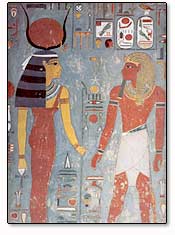 So what did men wear before the development of
pants? So what did men wear before the development of
pants?
The ancient Egyptians wore dresses and skirts. Going
further back, so did the ancient Sumerians. Alexander the Great
conquered the whole world while wearing a skirt. 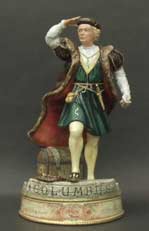 The
Greeks wore togas, and the Chinese wore dresses (yes, men too). The
Greeks wore togas, and the Chinese wore dresses (yes, men too).
How long did this men in skirts thing go on? Well, just have a look at Christopher Columbus
here. He's wearing a lovely green tunic, tights, and leather
shoes, with a large overcoat and leather beanie. Not exactly
the striking picture of manhood that we often think about in this
day and age. I imagine that if you'd have told Chris that he
looked like a girl in that skirt, he'd have stuck you pretty quick
with that knife he's got...
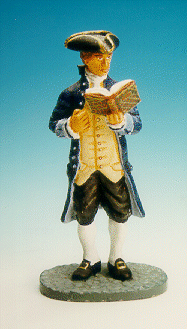 To continue this little fashion parade, let's have a look
at Thomas Jefferson. He's not wearing pants either. He's
wearing breeches. About 1760 most men begin wearing breeches, a tight garment worn from
the waist to the knee with stockings covering the rest of the leg,
"Britches" was an informal word for breeches. To continue this little fashion parade, let's have a look
at Thomas Jefferson. He's not wearing pants either. He's
wearing breeches. About 1760 most men begin wearing breeches, a tight garment worn from
the waist to the knee with stockings covering the rest of the leg,
"Britches" was an informal word for breeches.
Trousers probably derived from the words trousers-- drawers,
trousses--trunk
hose, and/or trousse--to cover, truss. They were looser than the tight
pantaloon were favored for daytime wear while pantaloons were more evening
attire. Trousers were worn over breeches when horseback riding to keep the more
formal clothing clean.
Sailors had been wearing the looser fit work trousers since the 1580s
since the legs could be rolled up for wading ashore or climbing
rigging. These pant-like garments were strictly for the lower class
males however. Ladies and Gentlemen wore skirts until 1760.
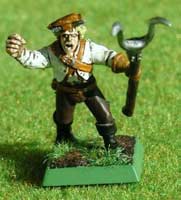 The French revolution of 1789 was also a revolt against breeches as
being too upper class. The country peasant trouser look was in. The French revolution of 1789 was also a revolt against breeches as
being too upper class. The country peasant trouser look was in.
In 1846 Sir Harry Lumsden, commanding as English troop in Punjab, India
traded in his bright white trousers for pajama bottoms to find relief from
the heat. To disguise them he colored them to blend with the local terrain
using mazari, a native plant. Thus the birth of Khaki, the Hindu word for
"dust". Amazing the things you learn on the internet, eh?
Another word which is interchangeable with pants and trousers is
slacks, which was coined by the Haggar Corporation in the 1940s as a
promotion for their casuals pants, to be worn during your
"slack" time between work and sports.
So, now that you have educated yourself on the history of men's
clothing, you can see that pants are just some kind of recent
fad. Men wore skirts for at least ten thousand years.
We've only been wearing pants for the last two hundred. The vast
majority of the male population of the planet still wears skirts
today!
THE RELIGIOUS THING
If you don't want to read this part, you can skip
it and go straight to Hiking in Skirts.
Some people I've talked to - specifically some strongly opinionated Fundamentalist Christians
I know - sometimes reject
the idea that men should wear skirts on religious grounds. This is
just the usual repression and if thought out rationally the arguments
don't hold water. A skirt is obviously a modest garment. Of
course a lot of the argument surrounds Deuteronomy 22:5 "A
woman must not wear men's clothing, nor a man wear women's clothing, for
the LORD your God detests anyone who does this." We aren't
talking about that, though. We're talking about wearing 'gender
correct' clothing. I'm really not interested in wearing high heels -
even though that particular fashion was invented for men too... If someone hits you with
Deuteronomy 22:5, have them read
verse 30 in the same chapter. "A man shall not take his
father's wife, nor discover his father's skirt." A skirt is
traditionally a
male garment.
Well, lets go ahead and ask the usual question, "What would Jesus
do?" Specifically, what did Jesus wear? Well, he wore a tunic
or Alb, as illustrated below, tied with a sash or cord. Looks remarkably like a dress, doesn't
it?
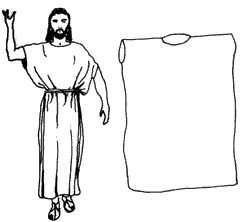 |
|
Tunic or Alb
Illustration from Madelieine S. and J. Lane Miller,
Harper's Encyclopedia of Bible Life (Third Revised Edition,
Harper & Row, 1978), p. 55. |
Jesus was rather comfortable with himself, as evidenced from John 13:4, 5
"He riseth from supper, and laid aside his garments; and took
a towel, and girded himself. After that he poureth water into a bason,
and began to wash the disciples' feet, and to wipe them with the towel
wherewith he was girded." Jesus was comfortable using a towel
as a skirt. I don't think that anyone assumes that Jesus was a cross dresser.
What about the prophets? What did the prophets wear?
Traditionally, sleeveless cloaks - just like the alb above - and the
Priests all wore them too. If you read Isaiah 20, you can see that Isaiah prophesied for three years
while completely naked, but that was rather unusual. Maybe it's a
bad example to use here...
Interestingly enough, we can ask the question, "What does God
himself wear?" The Bible provides the answer in Ezekiel 16: 1,
8 "Again the word of the LORD came unto me, saying... 8 Now when I passed by thee, and looked upon
thee, behold, thy time was the time of love; and I spread my skirt over
thee, and covered thy nakedness: yea, I sware unto thee, and entered into
a covenant with thee, saith the Lord GOD, and thou becamest mine."
God wears a skirt! Imagine that! I could go a lot further
and give a lot more references. Let's just say that the Pope doesn't
wear pants and leave it at that. If a fanatic gives you a hard time
about being in women's clothing, show them your scriptures and challenge
them to show you where the Bible says that men have to wear pants.
Trust me, it ain't in the book.
Here are a few quick references.
1
Samuel 15:27 Samuel
wore a skirt.
Psalm
133:2 Aaron, the High Priest, wore a skirt.
Haggai
2:12 You shouldn't use your skirt for eating.
Zechariah
8:23 Jews wear
skirts. (Hey! I'm part Jewish!)
Anyway, that's enough of that... If you need more references on
body shame and religion, you can read Is
Nakedness a Sin? on another section of this website.
HIKING IN SKIRTS
"So, what has all of this to do with hiking?", you are
probably asking yourself. Well, I'm getting to that.
If you've read much of this website, you've probably figured out
that whenever possible I hike naked,
hike nude, and hike
natural. The trouble is that on well traveled trails, this isn't practical, and in
some cases isn't desirable. At 40 below, your sensitive parts freeze
pretty darned quick. Trust me on that.
For the most part, though, I hate pants. I'm not even very keen
on shorts. (I didn't even get
married in pants. I got married
in a Kimono.)
So, what's the next best thing to being a natural animal in his (or
her) natural habitat? Skirts. There are a couple of very good
reasons to wear skirts in the backcountry, and some are obvious and some
are not. There are also some reasons and circumstances not to
wear a skirt in the backcountry, and those apply to women as well as
men.
Let's start with the basics: Anatomy. Now, unless you are
less than about a year old, it isn't going to be any secret to you that a
man has some special dangly parts. If you aren't familiar with this,
you may need to have an adult explain it to you. A man has a penis
and two testicles suspended in the hammock-like scrotum. (Wondered
how I'd get the hammock reference in, didn't you?) Now this whole
'package' is designed to dangle. There are some very good reasons
for the dangling. One of them is virility. The testicles need
to be a few degrees cooler than the rest of the body to effectively
produce viable sperm. Wearing restrictive clothing is bad for
virility. Just ask any urologist. I suppose that generously
endowed men may need something to keep their dangly parts from dragging
the ground, but I don't have that problem personally.
That sort of brings us around to underwear. Traditionally,
nothing is worn under the skirt. Underwear is one of those
relatively new fads as well. The original purpose of underwear was
to provide a smooth, soft garment against the skin instead of the rough
outer garment. Secondly, it was to keep the outer garment clean. Washing
machines and modern fabrics have eliminated the need for these functions.
There is no health benefit to underwear, and there are possible health
consequences. One of these consequences is sweating and
chafing. Other, more serious consequences can be the fostering
of yeast, fungal, and bacterial infections.
As one clever person defined it, "monkey
butt = ape a$$, it is a condition when sweat has maxed out on the dark
side of your back side. The moisture no longer is wicked from the skin but
remains in the valley of thunder and wind. The friction/heat created
between the hills that make the valley of thunder and wind dries the
surface on the valley floor to the extent that the floor is worked
painfully dry. Some common factors that may cause this anomaly range
from excessive thunder and wind in the valley floor to a misguided wipe by
the sacred valley cloth. But the over riding factor in the cause of ape
a$$ and monkey butt is moisture."
A lot of hikers are wearing wicking underwear designed to redirect the
sweat and allow rapid evaporation. A personal observation, however, is that hiking nude
(admittedly not always
possible, practical, or desirable), or in a Kilt, Sarong, or Macabi Skirt
will also allow the ventilation necessary to allow this sweat to evaporate
normally. Wearing loose hiking shorts with no drawers will generally have
the same benefit, but it isn't as good as a skirt-like
garment.
It interesting that equatorial tribe members who live their lives nearly nude
have few skin ailments and no problems with chafing. Once they adopt
clothing, brought to them by well intentioned missionaries, they have all kinds of skin problems. Your skin is designed NOT
to be clothed, and when it isn't it functions normally.
Of course, some people are worried about modesty. I'm not
generally one of those people, but there are places and times where you
don't want to be mooning a bunch of girl scouts. A skirt is
amazingly modest, and it is easy and 'safe' to change into shorts, pants,
long underwear - or take those things off - while wearing a skirt.
It's much easier than trying to change clothes inside a tent, hammock, or
even inside a sleeping bag. Of course, I just wander off into the
woods to change, but some people don't like to do that for some
reason... (Lions and tigers and bears, oh my!)
The further aspect of privacy and modesty afforded by a skirt is while
trying to fill in a cat hole. From time to time someone will walk up
and 'catch you' in the latrine area. This is one fulfillment of the
saying, "Getting caught with your pants down." This can be
particularly troubling to some folks, especially if you've only got one
leg in your shorts to begin with. The skirt is a perfect and
portable privy cover. If you are squatting in your skirt and someone
walks up, you can just stand up and you're not fumbling with trying to get
your pants back on...
It will probably be obvious to you that a skirt provides better airflow
around the legs than pants or shorts and so skirts are cooler in the
summer heat than pants or shorts - but there's more to it than that.
Ever wonder why Arabs wear long skirts in the desert? Even though it
is extremely hot during the day, the Arabs wear heavy long robes (dishdashas)
to RETAIN their perspiration, which creates a dampness that cools their
bodies. By retaining their moisture in this way, they are much more
water-efficient as well - they can carry less water. The robes themselves
are very loose (rather like Roman togas), and the extra heat caused by the
black color causes increased upward convection of the air between the
cloth and the body. This additional air circulation actually aids in
evaporation and thus results in better cooling. The idea is very similar
to a 'swamp cooler' - the robes are air-conditioned! A long skirt of
the proper material can work in a similar way - portable air
conditioning.
It may not be so obvious that skirts can be warm in cold weather.
This is counter-intuitive and something you have to experience to properly
appreciate. Just remember that all those Scottish Highlanders wore
kilts in the winter time too.
The last major benefit of skirts is freedom of movement. Unless a
skirt is cut very narrow, there is a perfect freedom in a skirt that can
only be obtained by the baggiest of shorts.
Having said all of that, I will note that pants do have certain
practical advantages - especially when riding horseback and in extremely cold weather.
Rather chubby people may also have some thigh-rubbing issues that cause
thigh chafing, but
that's a weight problem not a garment problem. Pants do have a place
for certain activities and
environments, just like space suits. I ain't gonna wear a space suit
in the woods either...
KILTS
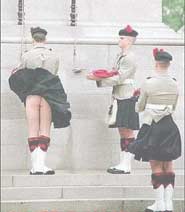 The most commonly
known male skirt is the kilt, as worn by manly Scotsmen for
centuries. The definition of a kilt is, "A knee-length skirt
with deep pleats, usually of a tartan wool, worn as part of the dress for
men in the Scottish Highlands." The most commonly
known male skirt is the kilt, as worn by manly Scotsmen for
centuries. The definition of a kilt is, "A knee-length skirt
with deep pleats, usually of a tartan wool, worn as part of the dress for
men in the Scottish Highlands."
Traditionally, nothing is worn under a kilt, and the wind and a chance
flick of a shutter can sometimes be used to verify that.
Kilts are available from many places, and can be found readily.
One online source is http://www.utilikilts.com/
- American Utility Kilts for Everyday
Wear. In our context, the Survival
Kilt looks choice. Gotta love those pockets! Another for hiking is Mountain
HardWear's Mountain Kilt, but they don't have the range of sizes that
Utilikilt does.
I don't have any pictures of me in a kilt. I'll try to fix that
when I have some time.
SKIRTS
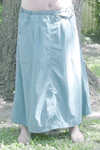 A kilt
is a very specific thing. Skirts, however, come in all shapes and
sizes, and indeed, kilts are just a specific kind of skirt - and most
kilts are rather heavy. There is
one skirt, though, that is specifically designed for men - with belt loops
and pockets no less - that is light and comfortable. You can read a review about the
Macabi
Skirt for men on BackpackGearTest.org, or you can visit the Macabi
Skirt website directly. They make them for women too. A kilt
is a very specific thing. Skirts, however, come in all shapes and
sizes, and indeed, kilts are just a specific kind of skirt - and most
kilts are rather heavy. There is
one skirt, though, that is specifically designed for men - with belt loops
and pockets no less - that is light and comfortable. You can read a review about the
Macabi
Skirt for men on BackpackGearTest.org, or you can visit the Macabi
Skirt website directly. They make them for women too.
While I apologize for the unattractiveness of the model, I've got some
pictures of a Macabi skirt here.
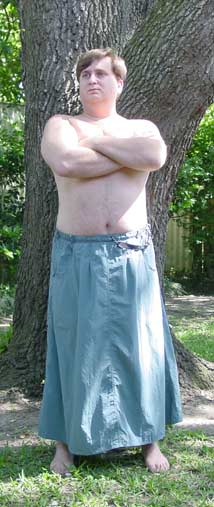 |
The Macabi skirt is a very soft and
comfortable garment that is works quite well as it comes. It
is, however, very cleverly designed to do a few tricks. These
are detailed below, but you are encouraged to get all the details by
reading the Macabi
skirt reviews on BackpackGearTest.org. It starts out at ankle
length and it will keep the wind and the bugs off you surprisingly
well. It can get shorter, however... |
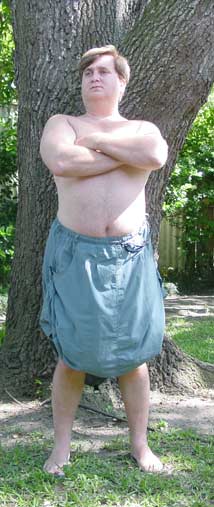 |
Using the built in side snaps, you can
hitch it up to make it a little shorter. That's about knee
length - proper kilt length, even if it looks a little baggy. |
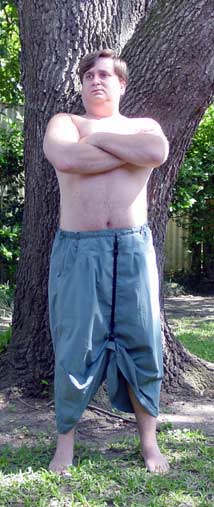 |
Using the PantClip (tm) you can turn it
into something like pants. |
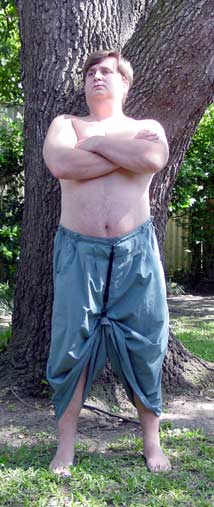 |
Shortening the PantClip (tm) will make
the legs shorter. |
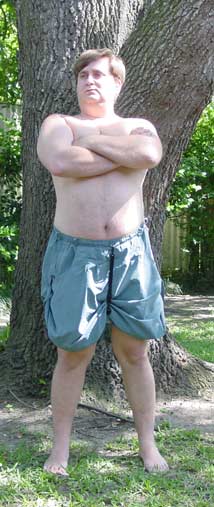 |
Using the PantClip (tm) and the side
straps makes something like shorts - but much more airy and
comfortable. |
 |
Further shortening the PantClip (tm) and
rolling the legs makes shorter shorts. |
 |
Rolling the legs all the way, and
tucking the back of the skirt under the front waist band makes a
swimsuit in the tradition of the tucked loincloth. |
SARONGS
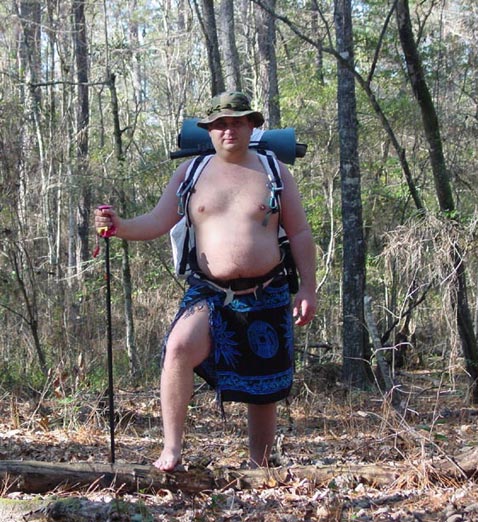 Sarongs are multi-functional. I call it a sarong, but depending on the
country you're in it can have various names. Pareo, Pareau, Pakome
(Thailand), Lava-Lava (Samoa), Sulu (Fiji), Canga (Brazil), Malo (Tonga),
Ki-koi (Kenya), or Lunghi. Sarongs are multi-functional. I call it a sarong, but depending on the
country you're in it can have various names. Pareo, Pareau, Pakome
(Thailand), Lava-Lava (Samoa), Sulu (Fiji), Canga (Brazil), Malo (Tonga),
Ki-koi (Kenya), or Lunghi.
All the same thing... Any piece of cloth between 3x5 and 4x7 will do
nicely, but 'real' Sarongs always have interesting patterns or prints.
I have many and always carry one while hiking - even when I have
another kind of skirt - and sarongs have many
uses beyond the obvious. It's interesting to note that in this country the
'men in skirts' think is catching on, even though you get the 'are you
wearing a dress!!??' response from time to time. (See http://users.pandora.be/tripticdesign/sarong.html,
although the sarongs they show are larger than the ones I normally wear
for hiking.)
FINAL COMMENTS
Pants are more or less a European/American thing. Men in much
of the rest of the world wears skirts, kilts, dresses, or sarongs of some
kind. Whenever going to a foreign country I always wear the common
clothing of that culture, and have been pleasantly surprised over and over
again. It also makes you invisible in many respects. A white man in slacks
and a sports coat standing in a fourth world village is a beacon. A white
man wearing local clothing is much less interesting. When the local
clothing is nothing at all, and you're not wearing anything, you get much
greater acceptance because they can see that you're just like them and not
some alien being.
Having worn clothing of many kinds in many different
contexts, I find that the more comfortable and relaxed I am, then
the more comfortable people around me will be. I tend to wear
clothing that matches the culture I am in or visiting, and when I'm not
concerned about fashion or my social context, I wear whatever I find most
comfortable. I have never been one to concern myself overly with other
people's perceptions, hang-ups, or preconceived notions of reality.
I realize though, that if a man is going to wear something contrary to
popular fashion that some response must be formulated for both the curious
and the obstinate. When some dim-wit hits me with, "Dude!
Are you wearing a dress!?", I just tell them, "No, I'm wearing a
skirt.", and then take the opportunity to educate them. Jesus,
Buddha, Mohammed, Alexander the Great, Plato, all the Roman Legions,
Vikings, Scots, Indians, Orientals, Arabs, Arians, Negroes, and indeed all
of human kind wore skirts or skirt-like garments up until about the
1700s. The vast majority of people - men and women alike - still do.
Of course, in the course of doing anything unusual, I have
several ready responses.
Things like:
-
It's wash day, and I figured, 'What the hell?'
-
Why, yes, it is a skirt, and you can't have it either!
-
Why, yes, it is a skirt. Where's yours?
-
Don't you know those pants can make you sterile?
-
The voices told me to wear it.
Of course, my favorite is, "It is in accordance with
the prophecy." YMMV.
The bottom line is that there are many benefits to wearing
skirts in the backcountry, despite Colin Fletcher's dismissal of them in Complete
Walker IV when he says, 'I've never tried it and women don't wear them
on the trail, so there must be some reason they don't.' While I
admire Mr. Fletcher more than I can say in words, I think he's missing a
few things.
- Natural ventilation. (On page 530 of Complete Walker IV
Fletcher notes that the "Second law of Thermodynamic
Walking" is "Give your balls some air."
- #1 leads to #2. Hygiene. It's healthier and
cleaner. My skirt doesn't get funky like my shorts do.
- It's the closest thing to naked that you can come without actually
being naked. That spells COMFORT.
- Convenient access for the act of urination.
- Convenient access for the act of defecation.
- No zippers. If you've ever caught your willy in a zipper, then
you'll appreciate this aspect.
- It's cooler than any other garment. Skirts have their own
built in air conditioning.
- Doesn't strangle your dangle, and it's not a drag on your bag.
If you have suggestions or comments, or if you have a quip to add to
the list of things to say when people ask questions, please use the web form at the
bottom of this page. If you would like more information, you can
refer to the Unbifurcated Garments Resources
page.
Thanks!
Shane Steinkamp |